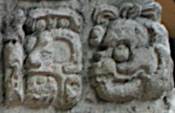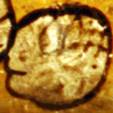
Eichhorn
CPN Altar U I2-J2
ti.<u:UK’> CHIH


AT-YT2021-lecture11.t0:49:24 = MatP2021-Zender.t0:21:39
TIK MT 219 (lid of vessel with stucco covering) TIK Burial 195 Stucco Drinking Cup
yu.<[k’i]bi> ta CHIH yu.<[k’i]bi> ta CHIH

mayavase.com
K1092 Z1
CHIH
· Chih = “pulque” is an alcoholic beverage made from the fermented sap of the maguey (agave) plant. Do not confuse this with the phonetically similar:
o chij = “deer”
o chik = “coati”
· Do not confuse pulque with atole, which is maize gruel – pulque is alcoholic while atole is not.
· Loughmiller-DtUFaPoCMCC.p7.fig4 renders this as chiih, with long-i.
· AT-YT2021-lecture11.t0:49:50 (discussing TIK MT 219 / TIK Burial 195 Stucco Drinking Cup): “This is a logogram for pulque – chih. It looks like a skull with big maguey leaves. So we think of pulque as a skeletal being because it’s buried in the ground, very much like the rhizomes of water lilies. And it dies, and then it ferments, and then you basically collect it, from the dead body of the pulque [plant]”.
· MatP2021-Zender.t0:21:39-22:25 (discussing TIK MT 219 / TIK Burial 195 Stucco Drinking Cup): These are the remains of a stucco drinking cup. And I think it was first pointed out by David Stuart that the text here records yuk’ib ta chih = “his cup for pulque”. And here instead of using the chi syllable – the hand that many of you recognize – there’s another syllabic sign which is in fact that skull with maguey fronds coming off of it; that’s the syllabic sign first recognized because of its substitution with the plain chi hand, but present here quite clearly. Potentially, it’s also the logogram CHIH for “pulque” since that’s what it depicts, but there’s no doubt that there’s many contexts in Maya art from this time that use it as just a syllable. If so, then it’s a syllable that originates from the word for maguey products, specifically, in this case, pulque proper.
· EB.p50.pdfp55.#6 chih (2) n. “pulque” gives references to seven examples, but considers them all (even the head/skull variants) to be pure syllabogram spellings. See below, under the syllabogram spelling of chih, for further details.
· The example from CPN Altar U I2-J2 is a detail from a photograph by Günther Eichhorn (guenther.eichhorn@gmail.com), found at: https://www.aerobaticsweb.org/images/HONDURAS/Honduras_0409_1536x1024.jpg.

AT-E1168-lecture6.t0:07:30(.9)
chi:hi






mayavase.com mayavase.com mayavase.com mayavase.com
K732 K1092 R1 K1092 Y1 K4481
chi:hi chi:hi chi{h} u.<chi:hi>
· EB.p50.pdfp55.#6 has “chih (2) n. pulque” with references to seven inscriptions, including K717, K732, K1092, and CPN Altar U I2-J2.
o I am unable to locate the chih written on K717.
o EB considers CPN Altar U I2-J2 to be syllabogram chi (the “head variant”), but it could (perhaps better) be considered to be the logogram CHIH.
o On K732, chi-hi is written as a label/tag on the iconography which shows a large, “lipped” vessel standing on the ground.
o There are three occurrences of the word chih on K1092:
§ K1092 R1 is in among the glyphs labelling the iconography. It’s the third glyph-block in a (rotated) L-shaped formation, between the two standing youths who are trying to help a third very drunk youth stand up.
§ K1092 Y1 and K1092 Z1 are two tags on the two long-necked vases with a tag labelling each as a container for chih. EB considers K1092 Z1 to be syllabogram chi (the “head variant”), but it could (perhaps better) be considered to be the logogram CHIH.
· There are contexts where the head variant only represents the sound chi (chi-, -chi-, -ch(i)), in which case it’s clearly a syllabogram. But there are also contexts where it represents the word for “pulque” = chih. In the latter case, it could still be considered to be a syllabogram chi which underspelled {-h} or it could simply be considered to be the logogram CHIH. See above, under logogram CHIH, for further details.